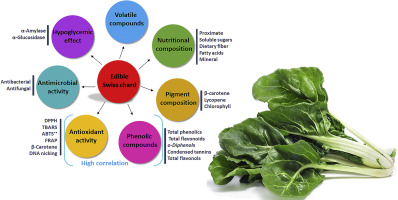当前位置:
X-MOL 学术
›
Food Res. Int.
›
论文详情
Our official English website, www.x-mol.net, welcomes your
feedback! (Note: you will need to create a separate account there.)
Wild edible Swiss chard leaves (Beta vulgaris L. var. cicla): Nutritional, phytochemical composition and biological activities.
Food Research International ( IF 7.0 ) Pub Date : 2018-10-11 , DOI: 10.1016/j.foodres.2018.10.039 Zeineb Mzoughi 1 , Hassiba Chahdoura 2 , Yasmine Chakroun 2 , Montaña Cámara 3 , Virginia Fernández-Ruiz 3 , Patricia Morales 3 , Habib Mosbah 2 , Guido Flamini 4 , Mejdi Snoussi 5 , Hatem Majdoub 1
Food Research International ( IF 7.0 ) Pub Date : 2018-10-11 , DOI: 10.1016/j.foodres.2018.10.039 Zeineb Mzoughi 1 , Hassiba Chahdoura 2 , Yasmine Chakroun 2 , Montaña Cámara 3 , Virginia Fernández-Ruiz 3 , Patricia Morales 3 , Habib Mosbah 2 , Guido Flamini 4 , Mejdi Snoussi 5 , Hatem Majdoub 1
Affiliation

|
Nutritional, soluble carbohydrates and aroma volatile profiles of Tunisian wild Swiss chard leaves (Beta vulgaris L. var. cicla) have been characterized. The chemical composition of an ethanol chard leaves extract, as well as its in vitro antioxidant, α-amylase and α-glucosidase inhibition activities were carefully evaluated. The results of the proximate composition showed that total carbohydrate fraction, mainly as dietary fiber were the major macronutrient (2.43 g/100 g fw), being the insoluble dietary fiber the predominant fraction (2.30 g/100 g). In addition, leaves of Beta vulgaris L. were especially rich in Mg, Fe and Ca (4.54, 2.94 and 2.28 mg/100 g fw) and very poor in Na (0.09 mg/100 g fw). Volatile profile revealed that non-terpene derivatives and sesquiterpene hydrocarbons were the essential classes of volatiles in the chard leaves. Myricitrin, p-cumaric acid and rosmarinic acid were characterized. Moreover, the ethanol extract of wild Swiss chard leaves revealed significant antioxidant capacity. Furthermore, a good enzyme inhibitory effects on α-glucosidase and α-amylase activities were observed. These findings highlighted the potential health benefits of wild Swiss Chard as a source of nutritional and bioactive compounds.
中文翻译:

野生的可食用瑞士甜菜叶(Beta vulgaris L. var。cicla):营养,植物化学成分和生物活性。
突尼斯野生瑞士甜菜叶(Beta vulgaris L. var。cicla)的营养,可溶性碳水化合物和香气挥发性特征已得到表征。仔细评估了乙醇唐莴苣叶提取物的化学成分,以及其体外抗氧化剂,α-淀粉酶和α-葡萄糖苷酶的抑制活性。近似组成的结果表明,总碳水化合物部分,主要作为膳食纤维是主要的主要营养元素(2.43 g / 100 g fw),其中不溶性膳食纤维占主要部分(2.30 g / 100 g)。此外,甜菜叶中的镁,铁和钙含量特别丰富(4.54、2.94和2.28 mg / 100 g fw),而Na含量极差(0.09 mg / 100 g fw)。挥发物特征表明,非萜烯衍生物和倍半萜碳氢化合物是唐莴苣叶片中必需的挥发物类别。表征了杨梅素,对枯草酸和迷迭香酸。此外,野生瑞士甜菜叶的乙醇提取物显示出显着的抗氧化能力。此外,观察到对α-葡糖苷酶和α-淀粉酶活性具有良好的酶抑制作用。这些发现凸显了野生瑞士甜菜作为营养和生物活性化合物来源的潜在健康益处。
更新日期:2018-10-11
中文翻译:

野生的可食用瑞士甜菜叶(Beta vulgaris L. var。cicla):营养,植物化学成分和生物活性。
突尼斯野生瑞士甜菜叶(Beta vulgaris L. var。cicla)的营养,可溶性碳水化合物和香气挥发性特征已得到表征。仔细评估了乙醇唐莴苣叶提取物的化学成分,以及其体外抗氧化剂,α-淀粉酶和α-葡萄糖苷酶的抑制活性。近似组成的结果表明,总碳水化合物部分,主要作为膳食纤维是主要的主要营养元素(2.43 g / 100 g fw),其中不溶性膳食纤维占主要部分(2.30 g / 100 g)。此外,甜菜叶中的镁,铁和钙含量特别丰富(4.54、2.94和2.28 mg / 100 g fw),而Na含量极差(0.09 mg / 100 g fw)。挥发物特征表明,非萜烯衍生物和倍半萜碳氢化合物是唐莴苣叶片中必需的挥发物类别。表征了杨梅素,对枯草酸和迷迭香酸。此外,野生瑞士甜菜叶的乙醇提取物显示出显着的抗氧化能力。此外,观察到对α-葡糖苷酶和α-淀粉酶活性具有良好的酶抑制作用。这些发现凸显了野生瑞士甜菜作为营养和生物活性化合物来源的潜在健康益处。









































 京公网安备 11010802027423号
京公网安备 11010802027423号